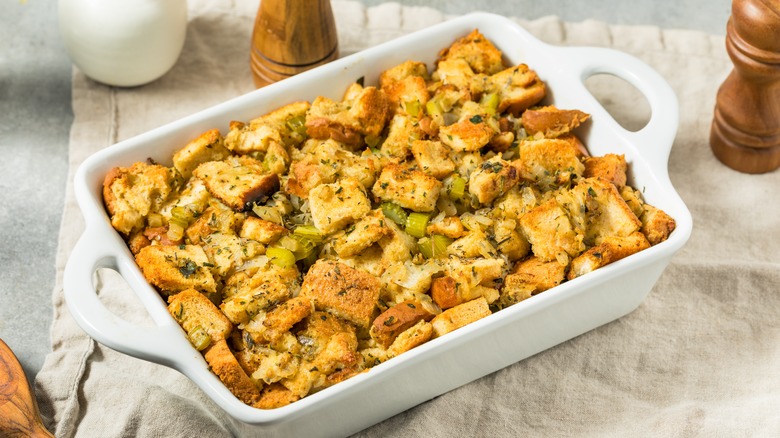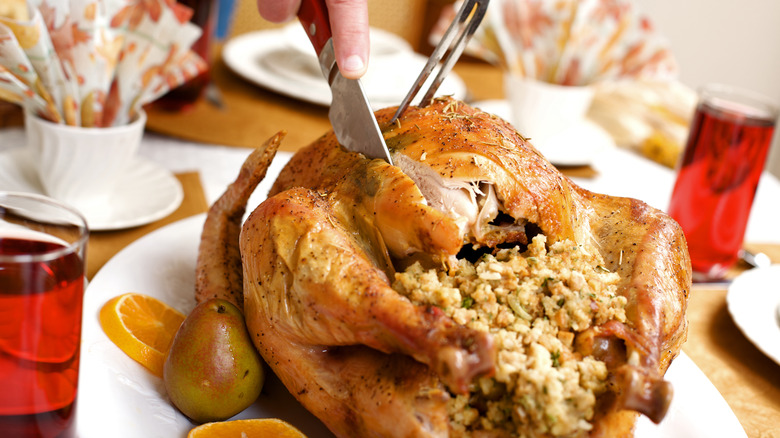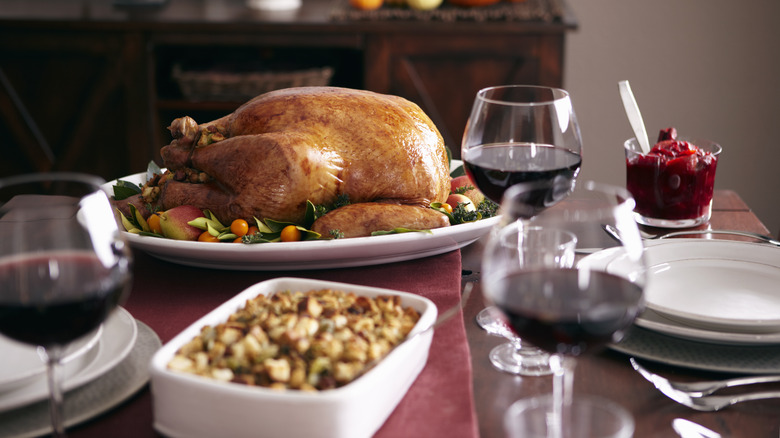What's The Difference Between Dressing And Stuffing?
This holiday season, you don't want to be caught lacking in the kitchen, especially when it comes to iconic dishes like stuffing and dressing. As integral parts of a Thanksgiving meal and key accompaniments to the turkey, knowing how to make these dishes is a must. But what even is the difference between dressing and stuffing? Are they the same, and can they actually be used interchangeably?
The short answer is no — despite common misconceptions, stuffing and dressing are not the same thing. The key difference is the way they are cooked. Both stuffing and dressing are made from a base of bread and a mixture of herbs, other flavorings, and add-ons like vegetables or meat. Stuffing, as the word implies, gets stuffed inside the cavity of the turkey and is cooked inside the bird to soak up its flavorful juices. Dressing, on the other hand, is cooked separately, and requires broth or stock to be added in directly in order to retain its moisture.
While it's true that anything can become stuffing if you put your mind to it, it can only earn that official name if you heat it up inside the turkey. By nature, this also makes all stuffings non-vegetarian or vegan, which is another important reason to distinguish between the two.
How to cook stuffing
Knowing how to safely cook stuffing inside your turkey can make or break your meal. It can even up the risk of cross contamination between raw ingredients if not done properly. You'll want to properly prep the stuffing ingredients before filling the turkey's cavity — this includes cooking any meats that are in the stuffing, and keeping dry and wet ingredients separate until just before stuffing the bird. By keeping these ingredients separate from each other and the raw turkey juices, you decrease the risk of bacteria formation inside the stuffing or the turkey itself.
Additionally, remember that the presence of stuffing increases your turkey's cook time by about 15 to 30 minutes, when compared to a non-stuffed bird. The center of your stuffing will also need to reach its safe internal temperature of 165 degrees, and the same goes for your turkey.
When it comes to the ingredients in the stuffing itself, there are a lot of great ways to customize a basic recipe to your preferences. Incorporating spices like paprika or chili flakes for a kick of heat, or even introducing some non-traditional ingredients like oysters, can all make for a unique stuffing. You can even elevate boxed stuffing by adding stock for more moisture before putting it in the turkey — it might need the extra help.
How to cook dressing
There are many reasons to opt for dressing instead of stuffing, and not just because it can be a great vegetarian alternative. Since it's cooked outside the turkey, typically in a casserole dish, it's a lot safer to make. While it's still best to keep your wet and dry ingredients separate until you're ready to cook, dressing has a lower risk of bacterial cross contamination — but what you gain in safety, you need to make up for in terms of moisture.
Since dressing doesn't absorb any juices from the turkey, many recipes use broth, butter, and/or eggs to add moisture to the bread base and marry the flavors together. To ensure your liquid really soaks in, try adding it in a cup at a time and stir after each increment to give your dry ingredients time to absorb it.
The exposed top layer of your dressing will crisp up in the oven, a feature unique to the dish that many people prefer (stuffing ends up way softer). To figure out which dish you like better, try a Thanksgiving practice round and have your family (or just yourself) sample various stuffing and dressing recipes. You may not have a spare turkey to stuff, but you should get a good idea of how each recipe tastes and which one you feel comfortable cooking. You and your guests will be grateful for the effort you put in ahead of time when choosing between these two holiday classics.



